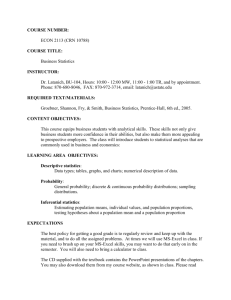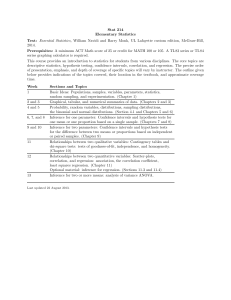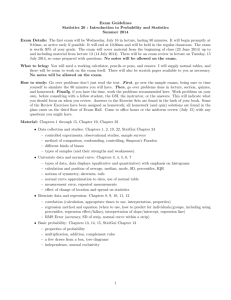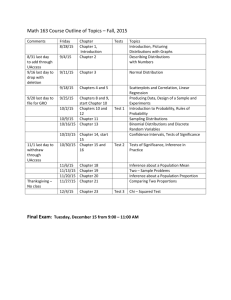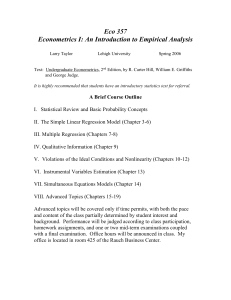THIS SYLLABUS IS SUBJECT TO MODIFICATION. THIS VERSION WAS...
advertisement
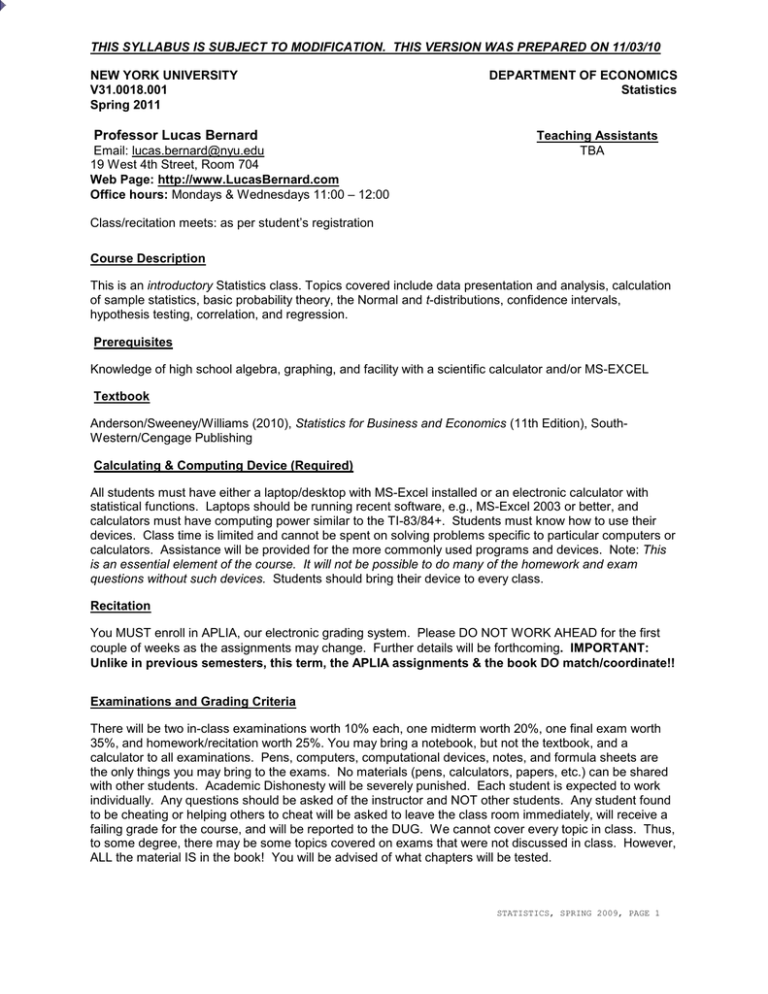
THIS SYLLABUS IS SUBJECT TO MODIFICATION. THIS VERSION WAS PREPARED ON 11/03/10 NEW YORK UNIVERSITY V31.0018.001 Spring 2011 Professor Lucas Bernard Email: lucas.bernard@nyu.edu 19 West 4th Street, Room 704 Web Page: http://www.LucasBernard.com Office hours: Mondays & Wednesdays 11:00 – 12:00 DEPARTMENT OF ECONOMICS Statistics Teaching Assistants TBA Class/recitation meets: as per student’s registration Course Description This is an introductory Statistics class. Topics covered include data presentation and analysis, calculation of sample statistics, basic probability theory, the Normal and t-distributions, confidence intervals, hypothesis testing, correlation, and regression. Prerequisites Knowledge of high school algebra, graphing, and facility with a scientific calculator and/or MS-EXCEL Textbook Anderson/Sweeney/Williams (2010), Statistics for Business and Economics (11th Edition), SouthWestern/Cengage Publishing Calculating & Computing Device (Required) All students must have either a laptop/desktop with MS-Excel installed or an electronic calculator with statistical functions. Laptops should be running recent software, e.g., MS-Excel 2003 or better, and calculators must have computing power similar to the TI-83/84+. Students must know how to use their devices. Class time is limited and cannot be spent on solving problems specific to particular computers or calculators. Assistance will be provided for the more commonly used programs and devices. Note: This is an essential element of the course. It will not be possible to do many of the homework and exam questions without such devices. Students should bring their device to every class. Recitation You MUST enroll in APLIA, our electronic grading system. Please DO NOT WORK AHEAD for the first couple of weeks as the assignments may change. Further details will be forthcoming. IMPORTANT: Unlike in previous semesters, this term, the APLIA assignments & the book DO match/coordinate!! Examinations and Grading Criteria There will be two in-class examinations worth 10% each, one midterm worth 20%, one final exam worth 35%, and homework/recitation worth 25%. You may bring a notebook, but not the textbook, and a calculator to all examinations. Pens, computers, computational devices, notes, and formula sheets are the only things you may bring to the exams. No materials (pens, calculators, papers, etc.) can be shared with other students. Academic Dishonesty will be severely punished. Each student is expected to work individually. Any questions should be asked of the instructor and NOT other students. Any student found to be cheating or helping others to cheat will be asked to leave the class room immediately, will receive a failing grade for the course, and will be reported to the DUG. We cannot cover every topic in class. Thus, to some degree, there may be some topics covered on exams that were not discussed in class. However, ALL the material IS in the book! You will be advised of what chapters will be tested. STATISTICS, SPRING 2009, PAGE 1 THIS SYLLABUS IS SUBJECT TO MODIFICATION. THIS VERSION WAS PREPARED ON 11/03/10 Notes: (1) Extra credit/makeup work is NOT available. If there is any student who feels that he or she may need an accommodation for any type of disability, please make an appointment to see me during my office hours. In general: no incompletes will be awarded. (2) This syllabus is an APPROXIMATE guide to what we will be doing. It should not be relied upon and is subject to change. For specific details, please check the course Blackboard! Hour 1 2 3 4 5 6 7 8 9 10 11 12 13 14 15 16 17 18 19 20 21 22 23 24 25 26 27 28 29 30 31 32 33 34 35 36 37 38 39 40 41 Topic Overview; Nature of Data; Critical Thinking Frequency Distributions and Histograms Statistical Graphics Measures of Center Measures of Variation Measures of Relative Standing Exploratory Data Analysis Review Exam 1 (Chapters 1 – 3) Fundamentals of Probability and Addition Rule Multiplication Rule: Basics Random Variables Binomial Probability Distributions Mean, Variance, and Standard Deviation for the Binomial Distribution Review The Standard Normal Distribution Applications of Normal Distributions Sampling Distributions and Estimators The Central Limit Theorem Normal Approximation of the Binomial Distribution Review Midterm (Chapters 1 – 6) Estimating a Population Proportion Estimating a Population Mean: ó Known Estimating a Population Mean: ó Not Known Testing a Claim about a Proportion Testing a Claim about a Proportion Testing a Claim about a Mean: ó Known Testing a Claim about a Mean: ó Not Known Testing a Claim about a Standard Deviation or Variance Inferences from Two Samples I Inferences from Two Samples II Review Exam 2 (Chapters 7 – 9) Correlation Regression More About Regression Multiple Regression Contingency Tables One-Way ANOVA Two-Way ANOVA STATISTICS, SPRING 2009, PAGE 2 THIS SYLLABUS IS SUBJECT TO MODIFICATION. THIS VERSION WAS PREPARED ON 11/03/10 42 43 44 Nonparametric Statistics Review for Comprehensive Final Exam (Chapters 10 – 12) Review for Comprehensive Final Exam (emphasis on Regression) STATISTICS, SPRING 2009, PAGE 3
